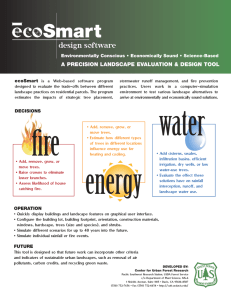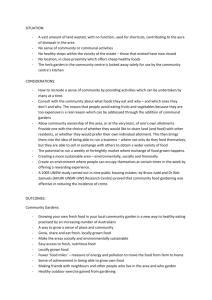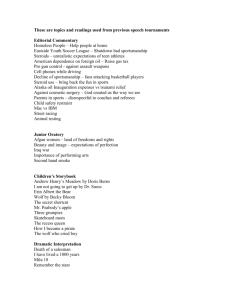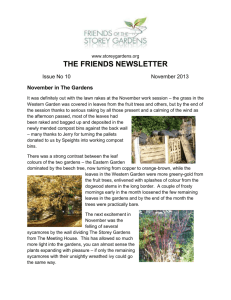A social benefits of civic nature
advertisement
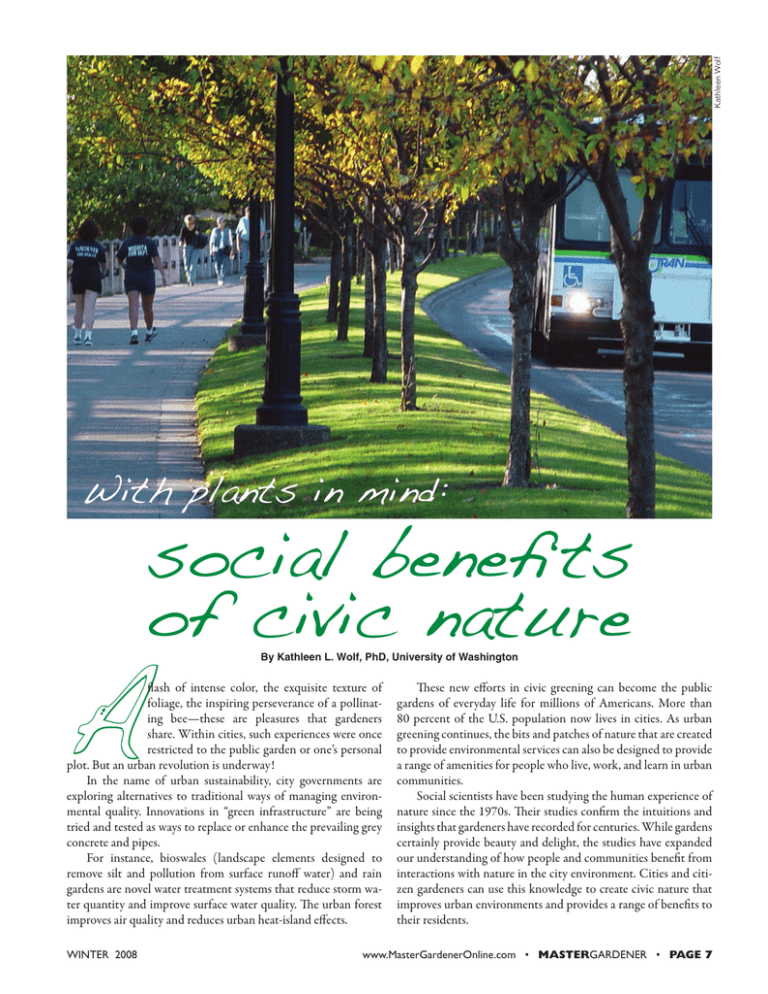
Kathleen Wolf With plants in mind: social benefits of civic nature A By Kathleen L. Wolf, PhD, University of Washington flash of intense color, the exquisite texture of foliage, the inspiring perseverance of a pollinating bee—these are pleasures that gardeners share. Within cities, such experiences were once restricted to the public garden or one’s personal plot. But an urban revolution is underway! In the name of urban sustainability, city governments are exploring alternatives to traditional ways of managing environmental quality. Innovations in “green infrastructure” are being tried and tested as ways to replace or enhance the prevailing grey concrete and pipes. For instance, bioswales (landscape elements designed to remove silt and pollution from surface runoff water) and rain gardens are novel water treatment systems that reduce storm water quantity and improve surface water quality. The urban forest improves air quality and reduces urban heat-island effects. WINTER 2008 These new efforts in civic greening can become the public gardens of everyday life for millions of Americans. More than 80 percent of the U.S. population now lives in cities. As urban greening continues, the bits and patches of nature that are created to provide environmental services can also be designed to provide a range of amenities for people who live, work, and learn in urban communities. Social scientists have been studying the human experience of nature since the 1970s. Their studies confirm the intuitions and insights that gardeners have recorded for centuries. While gardens certainly provide beauty and delight, the studies have expanded our understanding of how people and communities benefit from interactions with nature in the city environment. Cities and citizen gardeners can use this knowledge to create civic nature that improves urban environments and provides a range of benefits to their residents. www.MasterGardenerOnline.com • MASTERGARDENER • PAGE 7 Kathleen Wolf Children and youth may have the most to gain from green surroundings. Play in places with trees and vegetation can support children’s development of skills and cognitive abilities and lessen the symptoms of Attention Deficit and Hyperactivity Disorder (ADHD). Living in a green environment can improve school performance. Inner-city girls with more natural views at home show greater concentration and self-discipline. Urban roads that have nicely planted rights-of-way, and screened views of adjacent commercial land uses are judged more attractive by the public. At another level, drivers who see green road edges recover from stress more quickly, and tolerate feelings of frustration better than those seeing built edges. Might nature be one antidote to road rage? This article is an overview of findings about the psychological and social benefits that urban greening provides for people. The research reports range from the scale of individuals to communities, and consider both passive and active encounters with nature. Here are some highlights. Generally, people of all ages and cultural backgrounds prefer natural views to built settings in cities. Trees, in particular, enhance public judgment of visual quality in cities, and are highly valued elements of communities. While some people revere wilderness as the place to behold dramatic landscapes, studies show that everyday encounters with nearby nature are satisfying and cherished. Urban plants and nature are linked with all sorts of positive effects, and nature viewers may not even be aware of their response. Psychologists have studied the restorative capacities of natural settings, and the aspects of nature that support what we do. Work that demands focused attention (such as desk work or studying) for a lengthy period can result in mental fatigue, which can be expressed as irritability, physical tiredness, and inability to concentrate. Brief interludes in natural settings are mentally restorative, helping us to get back on track with work. Desk workers who have a view of nature report greater job productivity and satisfaction, and reduced absenteeism. Health and well-being Kathleen Wolf Kathleen Wolf Livable, supportive places More active lifestyles combat obesity, improve cardiovascular health, and increase longevity. Public health officials are concerned about increasing inactivity in urban communities, and the resulting long-term health consequences. One way to measure physical exertion is the metabolic ratio of an activity versus rest conditions. Gardening activities produce exertion ratios ranging from 2.5 for mowing the lawn, to 4.0 for raking or planting shrubs, to 6.0 for gardening with heavy tools or using a tiller. A gardener can work at home, volunteer at a park, or tend a traffic circle and gain better health. Urban greening also contributes to more walkable cities. Walking is a recommended moderate activity (having a 3.5 exertion ratio). Neighborhoods exert a significant effect on residents’ physical activity, and thus neighborhood design should be considered a public health issue. The presence of nature influences exercise perceptions and motivations. For instance, In cities and towns throughout the Pacific Northwest, concrete is giving way to civic nature—in plazas, around buildings, along streets, and in parking lots. Green infrastructure, as depicted in the photos on this spread, provides environmental benefits and can generate the joys of gardens in everyday life. PAGE 8 • MASTERGARDENER • www.MasterGardenerOnline.com WINTER 2008 Kathleen Wolf Kathleen Wolf people make more walking trips when they perceive that there are many natural features in their neighborhood. In less green neighborhoods, people judge distances to be greater than they actually are, perhaps leading to decisions not to walk. Physiological functions, the core processes of our bodies, are also linked with nature experiences. Hospital patients who have a view of nature recover faster from surgery and require less pain medication. Hospitals have begun to incorporate gardens and window views of nature for patients and for staff who are in demanding jobs. Stress is one of the most prevalent public health concerns of urban life. Views of nature rapidly reduce physiological stress response. Studies show that heart rate, blood pressure, and other body function measures return to normal levels more quickly when people view nature after a stressful experience. WINTER 2008 www.MasterGardenerOnline.com • MASTERGARDENER • PAGE 9 Social connections Experiencing nature provides a range of individual benefits. The social conditions of a community are also improved by the presence of landscape and gardens. Studies show that green spaces around homes provide outdoor settings where people gather, interact, and build relationships. Shared green spaces, particularly those having trees, help strengthen social ties among neighbors. A series of studies of inner-city neighborhoods shows green spaces with trees contribute to healthier, more supportive patterns of interrelations among residents, including greater sharing of resources. Individuals living in greener buildings reported more social activities and more visitors, knew more of their neighbors, reported their neighbors were more concerned with helping and supporting one another, and had stronger feelings of belonging. Neighbors with stronger social ties are more likely to monitor activity, intervening if problem behaviors occur and defending their neighborhoods against crime. Are green neighborhoods safer? The plant-to-safety link has been tested. In one study, residents of greener buildings reported fewer incidences of vandalism, graffiti, and litter than counterparts in more barren buildings. The trend extends to more violent crime. When one study Kathleen Wolf Storm-water management without the pipes becomes a public garden. compared police reports of crime and extent of tree and grass cover, the greener a building’s surroundings, the fewer total crimes were reported. This relationship was found in both property and violent crimes. People may also intentionally come together to green up their community through a community garden project or a “NeighborWoods” program. These collective actions may become the spark or catalyst that enables a community to develop self-organizing skills and resources. After completing a community greening project, organized citizens may turn their attention to other needs, such as school improvements or downtown redevelopment. Project participants build social capital, and adaptive learning within a community helps people focus their common will on a range of local needs. Communities that have greening programs may be more resilient and more capable of responding to catastrophic events and security risks. Though not all communities experience such empowerment, greening coordinators can enhance this process with strategic planning. Community development A well-managed urban forest contributes to community economics in a number of ways. Talented workers and firms are PAGE 10 • MASTERGARDENER • www.MasterGardenerOnline.com attracted to places that have high levels of amenities and environmental quality. More detailed economic assessments show that real estate values are enhanced by landscape and vegetation. Raw lot prices are about 20 percent higher due to retention of existing vegetation in new development. Market prices of homes are increased about 7 percent by the presence of trees in yards and at the property edge; homes near a naturalistic open space gain 10 to 20 percent in value. Trees and nature generate economic benefits for commercial and retail enterprises as well. In one study, rental rates were 7 percent higher for commercial office properties having a quality landscape. A Philadelphia, Pennsylvania, study found that neighborhood commercial corridors in “excellent” condition (including a green streetscape) are correlated with a 23 percent net rise in home value within one-quarter mile of the corridor, and an 11 percent net rise for those within one-half mile. Drivers viewing commercial settings (such as auto sales and motels) from a high-speed road expressed more positive impressions of a community with a roadside landscape that included trees, claiming willingness to pay from 7 to 20 percent more for goods and services there. The greener community was characterized as being a more appealing place for shoppers, including positive merchant interactions and product quality. In a series of studies of downtown business districts, shoppers report increased patronage and purchasing behavior in districts having a quality urban forest. Consumers report being willing to pay 9 to 12 percent more for goods and services in business districts having a mature tree canopy. Merchants pay close attention to the quality of indoor features, such as product layout, music, and store lighting, and these contribute to store image, which influences patrons’ perceptions. Shoppers accept higher prices for goods in stores having attractive settings and positive staff. Visual quality of the outdoor environment appears to also impact price behavior. WINTER 2008 Many garden magazines offer the latest and best information on the “how” of gardening practices and materials. Yet in the larger scheme of things, gardens and urban greening may be regarded as modest concerns in our society, casually thought of as mere beautification and efforts of personal aesthetics. In today’s urbanizing world, the question of “why” we should invest in civic nature is also important. The presence of plants in the daily activities and lives of urban dwellers generates profound … effects. We can focus on the environmental services provided by infrastructure innovations. Rain gardens, bioswales, and roof gardens are installed to encourage ecological management of water, air or energy. Landscapes of civic buildings— schools, libraries, city halls—are being designed and installed to reduce chemical use, enhance biodiversity, and respond to local ecosystems. Roadside plantings are becoming more amenable to wildlife and wetlands. Communities can also imagine such landscapes as small-scale public gardens that provide human services. Research on the human dimensions of nature experiences confirms what many gardeners intuitively know, that the presence of plants in the daily activities and lives of urban dwellers generates profound and important effects. Gardeners can partner with public organizations to help create nature patches that enhance sustainable cities and delight the urbanite. n About the Author Wolf is a research social scientist at the University of Washington, Seattle. Her work focuses on the human dimensions of urban forests and ecosystems, using theory and methods of environmental psychology. Information about Dr. Wolf ’s research program can be found at www.cfr. washington.edu/research.envmind/. This article, with citations, is available at: kwolf@u.washington.edu. WINTER 2008 from the University of California The California Master Gardener Handbook 3382 ISBN 978-1-879906-54-9 $30.00 Pests of Landscape Trees & Shrubs An Integrated Pest Management Guide, 2nd Edition 3359 ISBN 978-1-879906-61-7 $42.00 Abiotic Disorders of Landscape Plants A Diagnostic Guide 3420 ISBN 978-1-879906-58-7 $35.00 Pests of the Garden and Small Farm A Grower’s Guide to Using Less Pesticide, 2nd Edition 3332 ISBN 978-1-879906-40-2 $35.00 Wildlife Pest Control around Gardens and Homes 2nd Edition 21385 ISBN 978-1-879906-67-9 $25.00 Healthy Roses Environmentally Friendly Ways to Manage Pests and Disorders in Your Garden and Landscape 21589 ISBN 978-1-879906-49-5 $10.00 800-994-8849 Call: Click: anrcatalog.ucdavis.edu www.MasterGardenerOnline.com • MASTERGARDENER • PAGE 11
